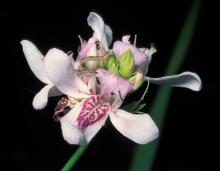Wildflowers, Grasses and Other Nonwoody Plants
Media

Species Types
Scientific Name
Justicia americana
Description
American water willow is common on gravel bars and other stream banks throughout much of Missouri. The dense colonies of emergent stems have leaves like a willow’s, but the two-lipped flowers resemble little orchids.
Media

Species Types
Scientific Name
Collinsia verna
Description
The flowers of blue-eyed Mary are only about a half inch wide, but this pretty wildflower makes up for it by usually appearing in abundance, covering a patch of forest floor with little sky-blue and white “faces.”
Media

Species Types
Scientific Name
Lamium purpureum
Description
Dead nettle, like its close relative henbit, is a common, weedy mint that, in early spring, can carpet wide patches of disturbed ground. Recognize dead nettle by the pyramidal look of its purple- or blue-tinted foliage.
Media

Species Types
Scientific Name
Houstonia pusilla (H. minima; Hedyotis crassifolia)
Description
Small bluet is a mat-forming winter annual that can color entire lawns blue with its tiny flowers. You can start learning to recognize it by noting the reddish-purple color at the center of the blue-violet flowers.
Media

Species Types
Scientific Name
Silene virginica
Description
Fire pink is a low, clump-forming perennial with many slender, spreading stems that are sticky from glandular hairs, with open clusters of bright red flowers. This showy native Missouri plant is growing in popularity among home gardeners.
Media

Species Types
Scientific Name
Houstonia longifolia (sometimes Hedyotis longifolia)
Description
The petals of long-leaved bluets are not blue; they are white, often tinged with pink. Look for it in rocky, open Ozark woods, prairies, glades, and old fields in the southeastern half of the state. It prefers acid soils.
Media

Species Types
Scientific Name
Claytonia virginica
Description
Our most widely distributed early spring flower, spring beauty has 5 white or pink petals with distinct pink veining, and 5 pink anthers. The narrow, bladelike leaves are fleshy. These flowers often grow in abundance, covering a patch of ground with the beauty of spring.
Media

Species Types
Scientific Name
Thalictrum thalictroides
Description
Rue anemone is a common and beloved spring wildflower. It blooms March–June. It and other woodland wildflowers require a forest habitat to survive, so they depend on the oaks, hickories, maples, and other trees that surround them.
Media

Species Types
Scientific Name
Ageratina altissima (formerly Eupatorium rugosum)
Description
White snakeroot looks very similar to thoroughworts, but it has triangular leaf blades that are more broadly angled or rounded at the base. White snakeroot is common statewide. It’s a toxic plant if eaten, so it’s good to be able to identify it.
Media

Species Types
Scientific Name
Eupatorium perfoliatum
Description
American, or common boneset has small, white flowerheads in flat-topped clusters at the top of the plant. The leaves are hairy, narrowly triangular, and in opposite pairs fused around the stem.
See Also
About Wildflowers, Grasses and Other Nonwoody Plants in Missouri
A very simple way of thinking about the green world is to divide the vascular plants into two groups: woody and nonwoody (or herbaceous). But this is an artificial division; many plant families include some species that are woody and some that are not. The diversity of nonwoody vascular plants is staggering! Think of all the ferns, grasses, sedges, lilies, peas, sunflowers, nightshades, milkweeds, mustards, mints, and mallows — weeds and wildflowers — and many more!





















